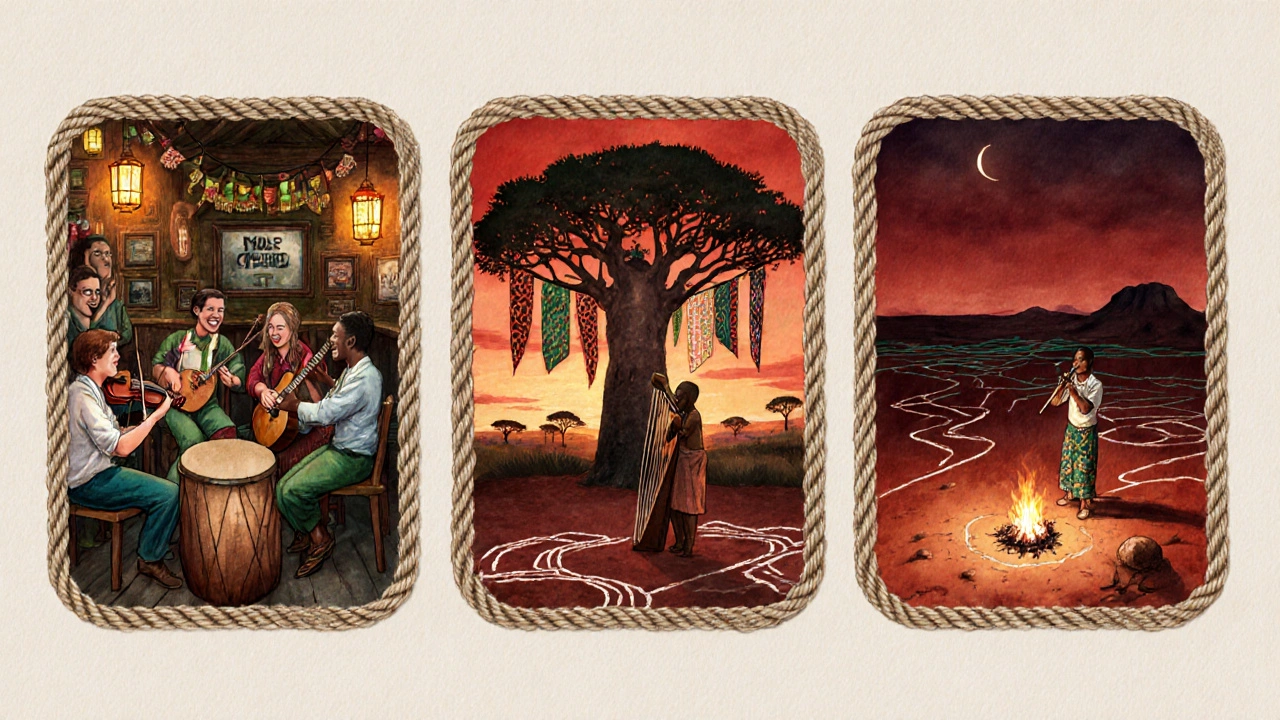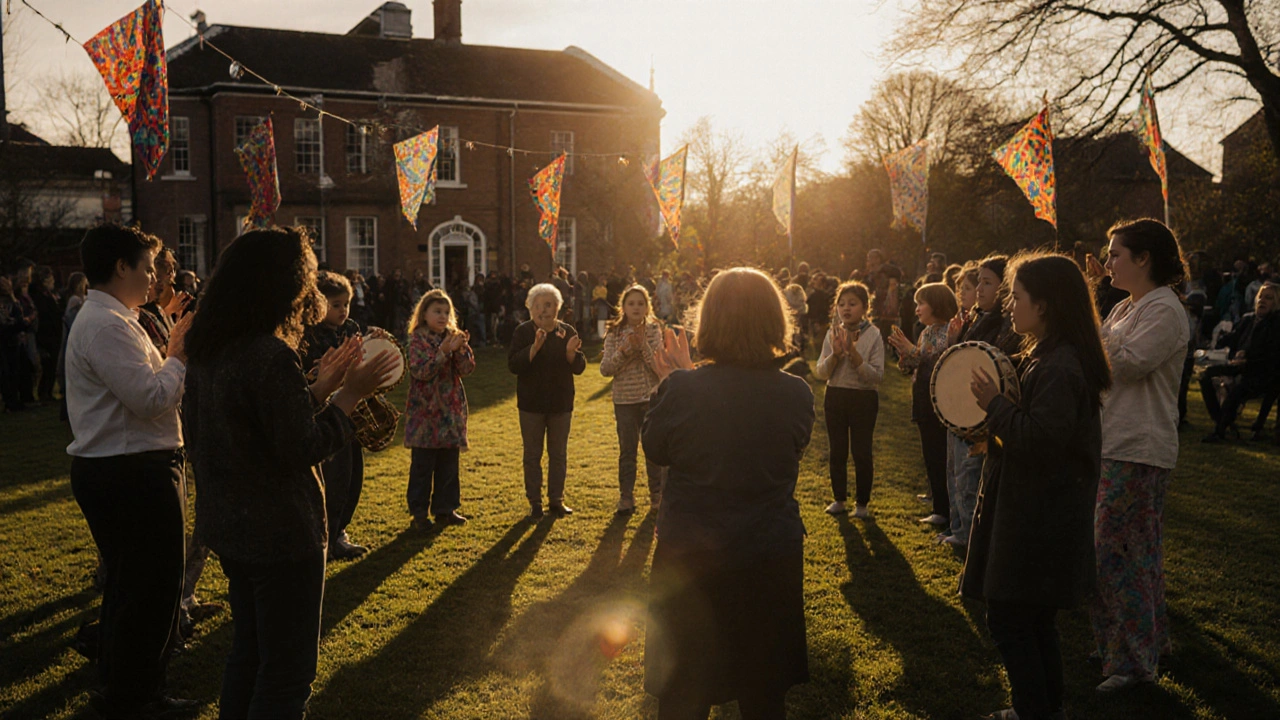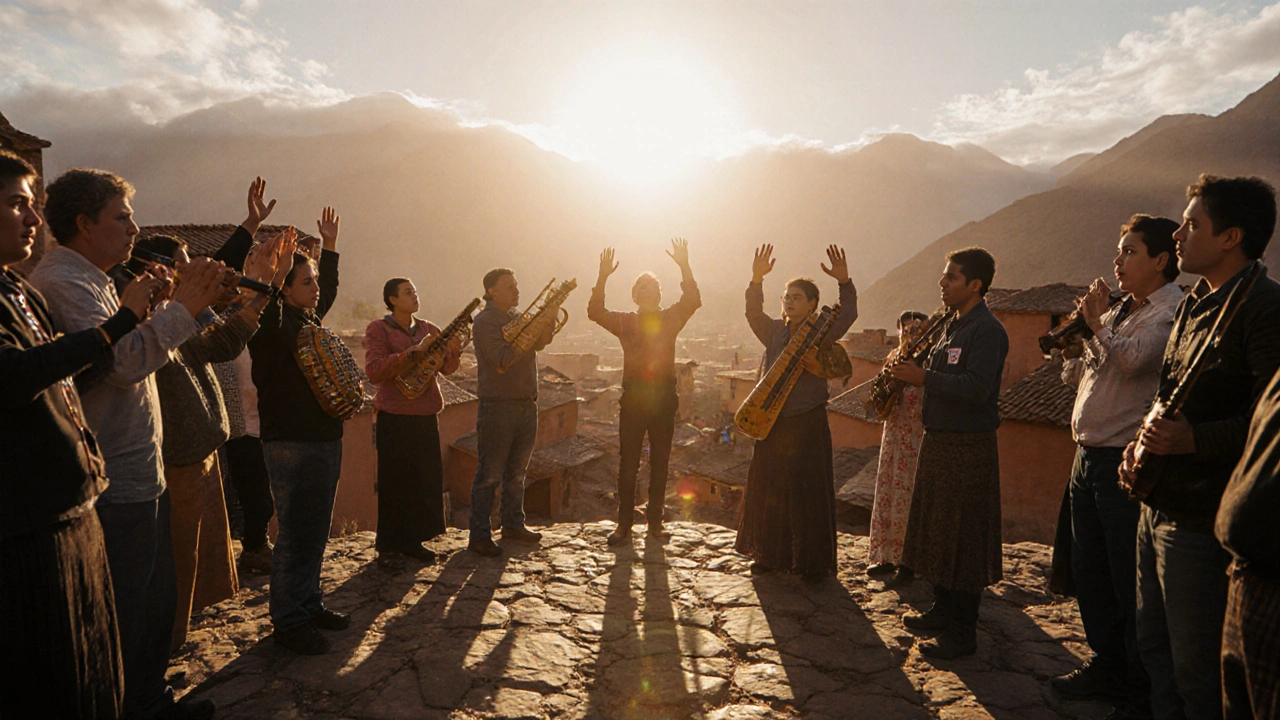Folk Music Impact Simulator
Click "Simulate Social Harmony Impact" to see how these factors affect community bonding through folk music.
When we talk about Folk Music the traditional, community‑based music passed down orally across generations, we often overlook its power to stitch people together. From village choirs in the Andes to street jam sessions in Dublin, the melodies and stories people share can smooth tensions, celebrate diversity, and create a sense of belonging.
What Counts as Folk Music?
In its broadest sense, Folk Music refers to music rooted in everyday life, performed by non‑professional musicians, and transmitted by ear rather than sheet. It isn’t tied to a single genre; it includes ballads, work songs, dance tunes, and ritual chants. Key attributes are:
- Community ownership - the whole group can join in.
- Oral tradition - lyrics and melodies evolve with each performance.
- Local language and themes - stories reflect regional history and values.
Because these traits keep the music flexible, it becomes a natural tool for building bridges.
How Folk Music Fuels Social Harmony
Researchers have identified three core mechanisms through which folk music promotes Social Harmony a state where individuals feel connected, respected, and cooperative:
- Shared Identity: Singing the same songs creates a collective memory that transcends age, gender, or ethnicity.
- Emotional Resonance: Melodies trigger empathy, allowing listeners to feel others’ joys and sorrows.
- Ritual Participation: Regular gatherings (festivals, circles, work chants) turn music into a predictable social ritual, reducing uncertainty and conflict.
These processes are not abstract; they manifest in everyday life, from a neighbor’s front‑yard jam to a national heritage celebration.
Real‑World Examples That Show the Power of Folk Music
Below are three vivid cases where folk traditions have actively knitted societies together.
- Irish Folk Sessions informal gatherings in pubs where musicians rotate tunes encourage locals and tourists alike to join a single circle, breaking down social barriers in a relaxed setting.
- West African Griots storyteller‑musicians who preserve history through song travel between villages, reminding disparate groups of shared ancestors and reinforcing regional solidarity.
- Australian Aboriginal Songlines vast oral maps that blend music, geography, and law guide travelers across the outback while teaching respect for the land and each other.
Each example shows how a simple melody can become a conduit for peace, identity, and mutual respect.

Key Elements That Make Folk Music an Effective Unifier
Not every tune works the same way. The following elements tend to amplify the harmony‑building effect:
- Community Participation: The more people can sing or clap along, the stronger the sense of belonging.
- Simple, Repetitive Structures: Repetition makes songs easy to learn on the spot, inviting newcomers to join.
- Local Language and Stories: When lyrics reference familiar places or events, listeners feel seen.
- Traditional Instruments - such as the bodhrán Irish frame drum or the kora West African harp‑lute - provide distinctive sounds that signal cultural identity.
- Oral Tradition: Because songs evolve, they stay relevant to current social issues while retaining historic roots.
When planners tap these ingredients, they’re more likely to see real, lasting cohesion.
Challenges and Opportunities in a Modern World
Folk music isn’t immune to pressure. Commercialization can strip songs of context, and urban migration sometimes dissolves the community base needed for live singing. Yet technology offers a lifeline: streaming platforms, virtual jam rooms, and mobile apps help younger generations access and remix traditional material.
One promising trend is the UNESCO Intangible Heritage program that safeguards folk practices by providing funding and global awareness. Projects that blend digital recording with community workshops preserve authenticity while widening reach.
Balancing preservation with innovation is the sweet spot for fostering harmony in today’s plural societies.
Practical Tips: Using Folk Music to Strengthen Community Bonds
If you’re a local organizer, teacher, or simply a neighbor who wants to spark unity, try these steps:
- Identify a locally loved folk song or create a simple chant about a shared goal.
- Gather a small group of willing participants - no instruments needed; claps and stomps work.
- Hold a brief, regular “music circle” (15‑30 minutes) before community meetings or festivals.
- Encourage everyone to add a line or a rhythm; record the session for later sharing.
- Invite schools or senior centers to join, building inter‑generational bridges.
Even a modest effort can ripple outward, turning a neighborhood gathering into a catalyst for broader social harmony.

Impact Snapshot: Folk Music Around the Globe
| Country / Region | Typical Folk Form | Social Harmony Outcome |
|---|---|---|
| Ireland | Pub sessions (instrumental reels & jigs) | Breaks down class barriers, encourages spontaneous collaboration. |
| West Africa (Mali, Senegal) | Griot storytelling with kora | Preserves lineage memory, mediates disputes through shared narratives. |
| Australia (Indigenous communities) | Songlines & didgeridoo chants | Reinforces land stewardship, unites dispersed clans. |
| India (Rajasthan) | Kalbeliya dance music | Celebrates marginalized groups, promotes cultural pride. |
| United States (Appalachian) | Ballad singing at community fairs | Creates cross‑generational dialogue, supports local economies. |
These snapshots show a common thread: folk music acts as a social glue, adapting to each culture’s unique needs.
Quick Checklist for Community Leaders
- Choose a song with clear, repeatable chorus.
- Make space for everyone to contribute (voice, rhythm, claps).
- Schedule regular, short sessions - consistency builds trust.
- Document recordings for archival and sharing.
- Link the music to local stories or upcoming projects.
Follow the list, and you’ll likely notice calmer meetings, more willing volunteers, and a stronger sense of “we’re in this together.”
Frequently Asked Questions
Can modern pop songs replace folk music in building community?
Pop songs can certainly bring people together, but folk music’s strength lies in its rootedness to local culture, simple structures, and participatory nature. Those qualities make it a more reliable tool for long‑term social harmony.
What if my community has no strong folk tradition?
Start by gathering any existing local songs-work chants, lullabies, regional hymns. Even a short melody can be adapted into a communal chant. Over time, it becomes a new folk tradition.
How can schools incorporate folk music into curricula?
Invite local musicians for workshops, let students learn a simple song, then have them perform at school assemblies. Pair the music with history lessons about the song’s origins for deeper impact.
Is there evidence that folk music reduces conflict?
Field studies in post‑conflict regions of the Balkans and Rwanda show that shared singing sessions lower stress hormones and increase trust scores among participants, supporting conflict‑reduction theories.
How do I record a community jam without disrupting the flow?
Place a simple omnidirectional microphone on a stable stand near the center of the circle. Let the session play naturally; later, you can edit the audio for sharing.
Whether you’re a city planner, a schoolteacher, or just a neighbor with a guitar, remember that folk music isn’t just entertainment-it’s a living bridge that can turn strangers into a community.

